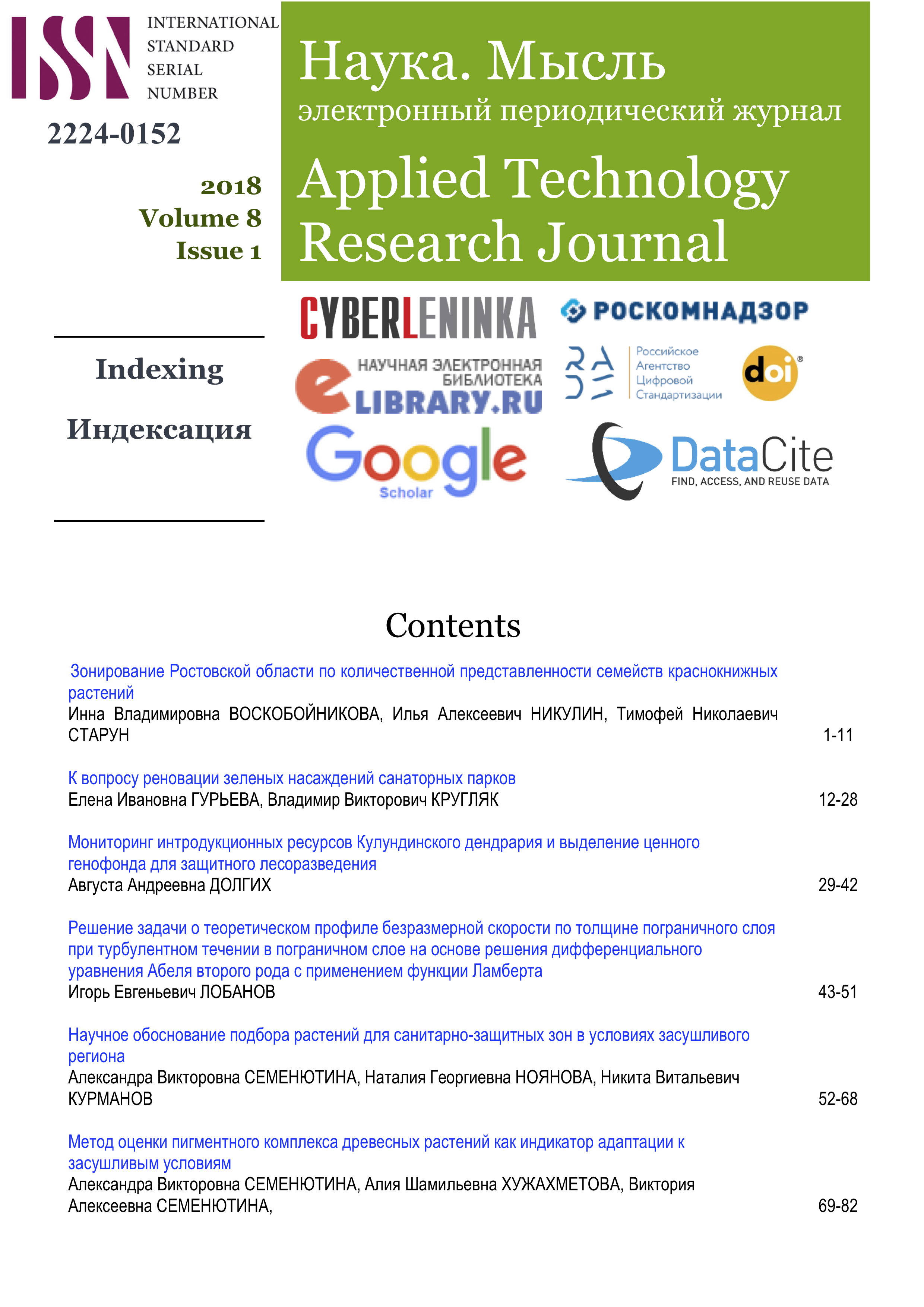Zoning of the Rostov region on the quantitative representation of families of red book plants
DOI:
https://doi.org/10.25726/NM.2018.1.1.001Keywords:
Rostov region, annotated list, species diversity, functional zoning, habitatsAbstract
The purpose of this study is to analyze the distribution of species and families of red book plants in the Rostov region. In the course of the work it was found that the habitats of these plants are distributed unevenly within the region.
As a result of researches allocation of habitats of the species and families of plants included in the Red book of the Rostov region on administrative areas is carried out. It was found that the occurrence of red book species from the families of Iridaceae, Hyacinthaceae, Paeoniaceae – the largest, habitats of these plants are recorded in all five zones of the Rostov region. The species of 15 families have minimal occurrence: Melanthiaceae, Primulaceae, Balsaminaceae, Polygalaceae, Cyperaceae, Cleomaceae, Rutaceae, Araceae, Limoniaceae, Zannichelliaceae, Nitrariaceae, Droseraceae, Menyanthaceae, Dipsaceae, Frankeniaceae. Their representatives have habitats in only one of the five zones.
The Association of districts of the Rostov region on representation of families of red book plants with allocation of zones is offered. Zoning scale is as follows: 1 zone - a very large number of families - 21 or more; 2 zone a large number – from 10 to 20 families; 3 zone average – from 6 to 9 families; 4 zone - a small number – from 3 to 5; 5 zone - very small – 2 or less families. A map of zoning areas of the Rostov region on the representation of families of red book plants.
References
2. Биоэкология редких и исчезающих древесных видов и их размножение в условиях интродукции / А.В. Семенютина, И.П. Свинцов, А.Ш. Хужахметова, С.С. Таран, Д.К. Кулик, В.А. Семенютина. М.: Наука. Мысль, 2015. 131 с.
3. Воскобойникова И.В. Растения красной книги Ростовской области. Новочеркасск, 2007. 34с.
4. Роль особо охраняемых природных территорий в сохранении биоразнообразия. Материалы международной научно-практической конференции, посвященной 10-летию Государственного природного заповедника «Ростовский», 26-28 апреля 2006 г., пос. Орловский, Ростовская область. Ростов-на-Дону изд. Ростовского университета. 2006. С. 15-18; 102-105.
5. Семенютина А.В., Свинцов И.П., Хужахметова А.Ш., Семенютина В.А. Экологические аспекты культивирования и многоцелевого использования редких и исчезающих древесных видов природной флоры // Современная наука: актуальные проблемы теории и практики. Серия естественные и технические науки. 2014. №11-12. С. 46-55.
6. Хрусталев Ю.П. Климат и агроклиматические ресурсы Ростовской области. Ростов-на-Дону: Батайское книжное издательство, 2002. 184с.
7. Электронная версия Красной книги. Интернет агентство «ВебСтрой».
==========
1. Boldyrev V.A., Nevsky S.A., Davidenko O.N. Biological diversity and nature conservation in the Saratov region. Vegetation. Saratov: Saratov University Press, 2011. 240p.
2. Bioecology of rare and endangered species and their reproduction under the conditions of introduction / A.V. Semenyutina, I.P. Svintsov, A.Sh. Khuzhakhmetova, S.S. Taran, D.K. Kulik, V.A. Semenyutina. M .: Science. Thought, 2015. 131 p.
3. Voskoboynikova I.V. Plants of the red book of the Rostov region. Novocherkassk, 2007. 34p.
4. The role of specially protected natural areas in the conservation of biodiversity. Materials of the international scientific and practical conference dedicated to the 10th anniversary of the Rostov State Nature Reserve, April 26-28, 2006, pos. Orlovsky, Rostov region. Rostov-on-Don publishing house. Rostov University. 2006. pp. 15-18; 102-105.
5. Semenyutina A.V., Svintsov I.P., Khuzhakhmetova A.Sh., Semenyutina V.A. Ecological Aspects of Cultivation and Multipurpose Use of Rare and Endangered Forest Species of Natural Flora. // Modern Science: Actual Problems of Theory and Practice. A series of natural and technical sciences. 2014. № 11-12. Pp. 46-55.
6. Khrustalev Yu.P. Climate and agroclimatic resources of the Rostov Region. Rostov-on-Don: Batayskoye publishing house, 2002. 184p.
7. The electronic version of the Red Book. Internet agency "WebStroy".




